|
72. Lopinga achine (Scopuli, 1763) / Woodland brown / Nymphalidae – Satyrinae
NL: boszandoog / D: Gelbringfalter / F: bacchante
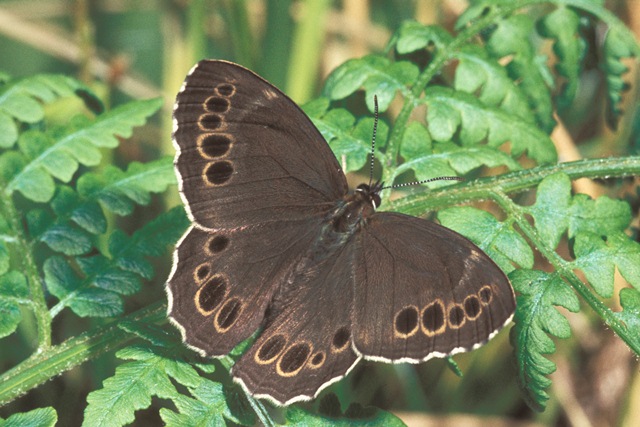 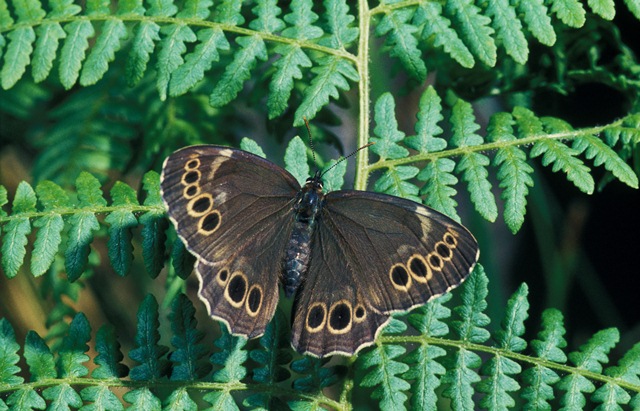 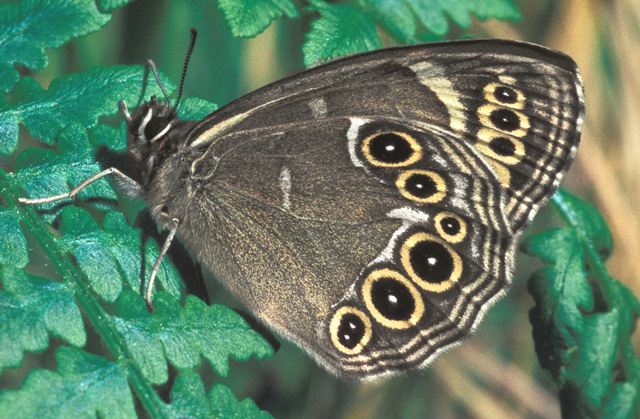
Photographs: Frits Bink ©.
Medium-sized or large, wing length 25 (24-26) mm. The species occurred up to about 1920 in Luxemburg and up to 1926 in Wallonia in open forest with a well-developed grass undergrowth.
Butterfly is on the wing from early-June until early-July, peaks mid-June. The species is known from sub-continental and continental climates, amplitude 8 to 18. Required heat sum 700°d and maximum tolerated 1800°d, corresponding climate windows 22 and 35 weeks.
The butterfly is a very striking appearance but not easy to observe because it stays most of the time up in the tree canopy, presently declining strongly in Europe.
Ecological characteristics
Behaviour over time
Overwintering: half grown larva in third instar, 10-13 mm in length, hidden in a grass tussock or litter layer.
Reproduction: oviposition starts after 2-3 days when the body contains 42 (36-48) eggs, observed potential production 2.5 times as much.
Larval feeding periods: 59 (52-66) days in summer and autumn and in next spring 34 (29-40) days from late-April until early-June.
Generations: always one.
Spreading of risk: not observed.
Life cycle: egg about 12 days; larva 44-47 weeks; pupa 18 (15-20) days.
Life span of adult: short, 2 weeks.
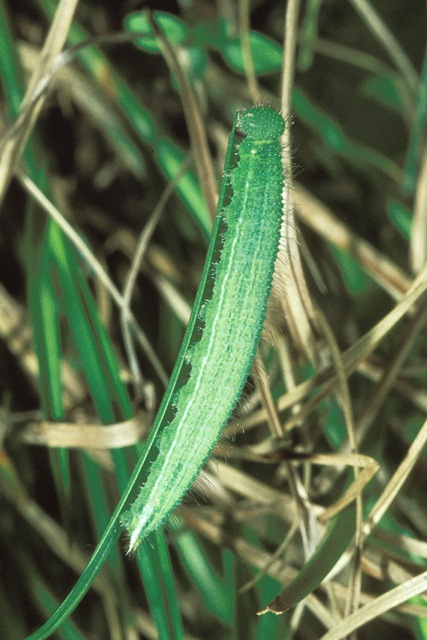 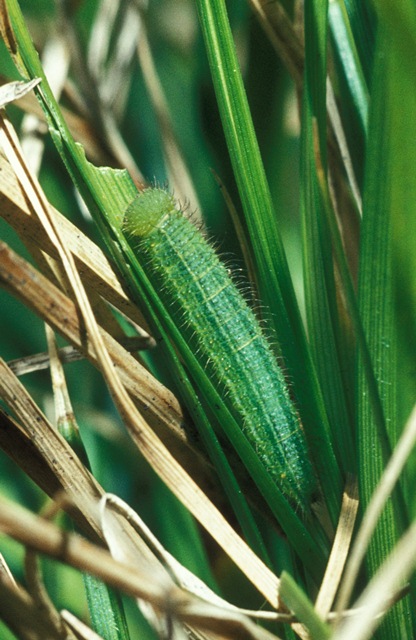
Photographs: Frits Bink ©.
Behaviour in space
From stay-at-home to migrant: stay-at-home, spatial requirement modest.
Finding a mate: male patrols and perches.
Orientation in the landscape: open wood with a grass undergrowth.
Oviposition: eggs dropped from resting place in a tree.
Defence
Threats from other organisms: vulnerable, no defence.
Threats from the environment: very sensitive to drought, in all stages.
Feeding habits
Adult: honeydew from coccids and aphids in the tree canopy and also from puddles.
Larva: when young, the larva eats old leaves, in spring young shoots. Melica nutans and Carex montana are examples of grasses which produce nutritious shoots early in the spring.
Larval foodplants
Plant species: Cyperaceae, Carex montana, C. remota, Poaceae, Festuca rubra, Melica nutans.
Journal
Rearing experiment based on specimens originated from Buttle, Gotland, Sweden:
15 July 1982: 2 females captured in a wood of Scotch pine, Norwegian spruce, juniper, rowan and willow, with an undergrowth of mountain sedge, nodding melick and wood false-brome.
17 July: two females produced 83 eggs in the first day.
29 July: eggs hatched.
9 August: larvae first instar (in a host-plant selection test mountain sedge (Carex montana) was preferred).
11 August: larvae moulted, they have 'tails'.
13 September: larvae 10-11 mm in length, third instar, spent most of daytime at the tip of the stems.
3 October: larvae appeared to have stopped feeding, they are now 11-13 mm in length.
Overwintered outdoors.
26 March 1983: one pot with four larvae taken indoors.
3 April: larvae were feeding and preferred the sunny side of the pot.
8 April: all in moult.
18 April: larvae nearly fully grown (host-plant test: wood millet and chalk false-broom refused).
25 April: first pupa.
12 May: first adult emerged.
15 May: 5 males emerged.
25 May: last adult emerged.
Parallel series after overwintering:
26 March: second pot remained outside.
8 May: larvae in last instar.
12 May: larvae full grown.
15 May: one larva fed on carnation grass (Carex panacea).
23 May: two females appeared.
9 June: last adult hatched.
Table 72-1. Results of dissections

Note: data of Karlson & Wiklund 1985: egg production 107 per female, longevity 11 and 14 days.
Table 72-2. Collection and observation localities
D, Steigerwald, 49° 39’N – 10° 23’E; 24 July 1984.
S, Gotland, Buttle 57° 25’ 09”N – 18° 34’ 38”E; 15 July 1982, 6 July 2004, seen c. 30 butterflies, not seen any 16 July 2004.
Fig. 72-1. Lopinga achine, phenogram adapted from Ebert & Rennwald 191b: 142.
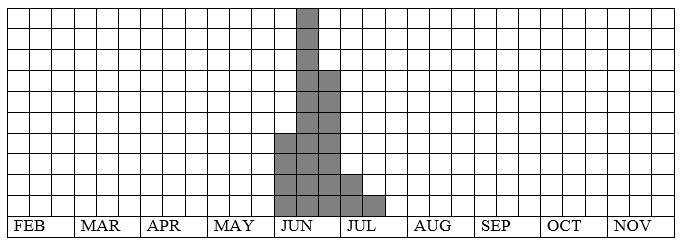
Fig. 72-2. Lopinga achine, habitat characteristics.
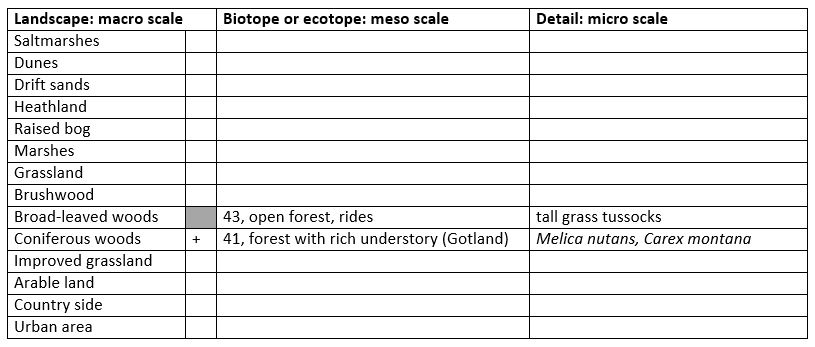
Fig. 72-3. Lopinga achine, climate matrix, heat-sums 700 - 1800°d.
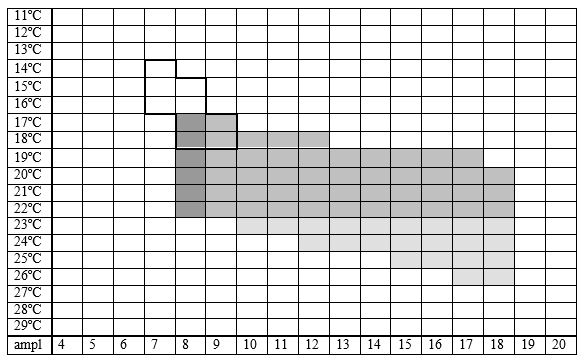
|










